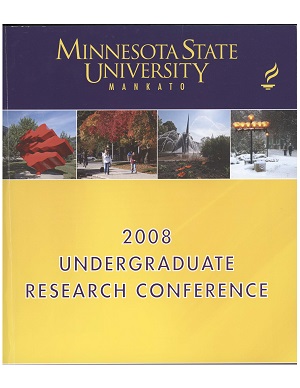Rates of Slope Erosion Near the New Sears Dormitory on the Campus of Minnesota State University, Mankato
Location
CSU Ballroom
Start Date
21-4-2008 10:00 AM
End Date
21-4-2008 12:00 PM
Student's Major
Geography
Student's College
Social and Behavioral Sciences
Mentor's Name
Forrest Wilkerson
Mentor's Department
Geography
Mentor's College
Social and Behavioral Sciences
Second Mentor's Name
Ginger Schmid
Second Mentor's Department
Geography
Second Mentor's College
Social and Behavioral Sciences
Description
The purpose of this project was to measure erosion rates on the slope adjacent to the new Sears Dormitory. Erosion rates were quantified by using dendrogeomorphic processes (tree coring), and the amount of root exposure of the trees. Forty three different trees were identified and located using a handheld Garmin 76csx GPS unit and the National Audobon Society Field Guide of North American Trees. Tree heights were determined with a tangent tree height gauge and a range finder, and the breast height diameter of all trees was measured using a Kenson measuring tape. A sample of trees was cored using a tree increment borer and transported to the lab for analysis. The cores were prepared and the age was defined by counting the rings of each core. After determining the age of the cored trees, the data was extrapolated to estimate tree age of all tree species within the study area by dividing the breast height by the estimated tree age to get an average growth rate in cm/yr. Vertical root exposure was divided by tree age to determine the minimum slope erosion rates in cm/yr. The results determined that the slope is eroding variably with a range of 0.06 cm/yr to 0.33 cm/yr. Using the minimum erosion rates, an estimate of when the building will be negatively impacted can be made. These minimal estimates maybe useful for future erosion mitigation efforts.
Rates of Slope Erosion Near the New Sears Dormitory on the Campus of Minnesota State University, Mankato
CSU Ballroom
The purpose of this project was to measure erosion rates on the slope adjacent to the new Sears Dormitory. Erosion rates were quantified by using dendrogeomorphic processes (tree coring), and the amount of root exposure of the trees. Forty three different trees were identified and located using a handheld Garmin 76csx GPS unit and the National Audobon Society Field Guide of North American Trees. Tree heights were determined with a tangent tree height gauge and a range finder, and the breast height diameter of all trees was measured using a Kenson measuring tape. A sample of trees was cored using a tree increment borer and transported to the lab for analysis. The cores were prepared and the age was defined by counting the rings of each core. After determining the age of the cored trees, the data was extrapolated to estimate tree age of all tree species within the study area by dividing the breast height by the estimated tree age to get an average growth rate in cm/yr. Vertical root exposure was divided by tree age to determine the minimum slope erosion rates in cm/yr. The results determined that the slope is eroding variably with a range of 0.06 cm/yr to 0.33 cm/yr. Using the minimum erosion rates, an estimate of when the building will be negatively impacted can be made. These minimal estimates maybe useful for future erosion mitigation efforts.
Recommended Citation
Gessner, Neil; Dan Krumwiede; and Dan O'Connor. "Rates of Slope Erosion Near the New Sears Dormitory on the Campus of Minnesota State University, Mankato." Undergraduate Research Symposium, Mankato, MN, April 21, 2008.
https://cornerstone.lib.mnsu.edu/urs/2008/poster-session-A/13



